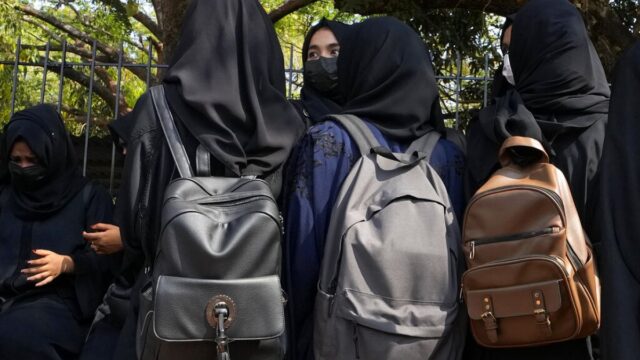The ban on the headscarf in Tajikistan is considered a reflection of the political line followed by the Government since 1997.
The President of Tajikistan, Imamali Rahman, has signed a total of 35 billsone of which prohibits wearing the veil or hijab in this Central Asian country.
The law prohibits the wearing of any clothing with Islamic symbols, including the centuries-old tradition known in Tajikistan as “like an artist“, in which children go door to door to raise pocket money on holidays.
With the bill, the country’s government aims to “protect national cultural values,”prevent superstition and extremism” and “avoid waste during festivals and ceremonies.”
Consequently, the person who violates the laws will be fined 7,920 Tajik somoni (about 692 euros) if he is a civilian, 54,000 somoni (4,720 euros) if he is a government official, and 57,600 somoni (5,035 euros) If it is a religious authority.
ISIS and Al Qaeda are in the spotlight
In Tajikistan, extremist tendencies constitute important taboos. There are currently 18 terrorist organizations and political movements on the country’s banned list. Organizations such as ISIS and Al Qaeda, as well as the Tajik Islamic Resurrection Party (TIDP) and Group-24, which were closed in 2015, are considered the main source of extremism and terrorism.
Finally, four people with Tajik passports were captured by Russian law enforcement in the attack against the Crocus City Hall, in the Russian capitalclaimed by the Khorasan branch of the self-proclaimed Islamic State (IS).
The attack of March 22, in which 144 people died and 551 were injuredwas one of the arguments that legitimized anti-extremist policies adopted by the current Executive of Tajikistan.
The resolution signed last Thursday It was the last in a series of neo-communist policies adopted by President Rahman during his 30 years in power.
30 years ago, during Tajikistan’s Russian-fueled civil war, which broke out in reaction to the prospect of establishing a state based on Islamic rule, and in which more than 100,000 people diedcurrent President Rahman came into conflict with the paramilitary forces of the Tajikistan Islamic Resurrection Party (TIDP).
In an agreement reached in 1997 thanks to UN mediation, a series of concessions to the opponent Tajikistan Islamic Resurrection Party (TIDP) and the disputes were peacefully resolved. five years of civil unrestwhich forced a million people to flee their homes during the war.
According to the agreement, representatives of the TIDP, a supporter of sharia, would share 30% of the Government, the TIDP would be recognized as the first post-Soviet party in Central Asia founded on Islamic values and would represent the Muslim majority in Parliament.
The first Islamist-oriented party in Central Asia
The dr. Helene Thibault, a French specialist on Tajikistan, has written that in 1997 the TIDP held positions as important as those of deputy prime ministerchairman of the State Customs Commission, vice-chairman of the State Customs Surveillance Commission and chairman of the State Oil and Gas Company, but in 2003, only 12 of the 53 bureaucrats holding key positions they remained in their positions.
The TIDP, the first Islamist-oriented party in Central Asiawhich in the 1990s attempted to introduce sharia law in Tajikistan, had difficulty in the 2000s opposing and challenging President Rahman, whose influence over the legislative, executive and judicial branches has been increasing.
Due to the changing political atmosphere,the party has become more moderate than before. Especially after the death of its founding president, Said Abdullah Nuri, in 2006, the TIDP leaders They criticized the veil ban in public and educational institutions imposed by President Rahman in 2009, considering it a violation of human rights, not Islam.
In 2015, figures linked to the TIDP were accused of having collaborated in the failed coup attempt in which General Abdulhalim Nazarzoda, a key government bureaucrat, lost his life.
That same year, the Supreme Court of Tajikistan ordered the party the cessation of its activities following the files provided by the Executive.
Today, Tajikistan, where 96% of the population identifies as Muslim and where almost 10 million people live, is listed among the “countries of particular concern” in the 2023 report of the United States Commission on International Religious Freedom (USCIRF).
A 2017 statement by the Committee for Religious Affairs of Tajikistan stated that 1,938 mosques had been closed in just one yearand that places of worship had become places like tea shops and medical centers.
The Government does not want religious education
The Parental Responsibility Law, which came into force in 2011, stipulates that Parents who send their children to receive religious education will be punished abroad, while, according to the same law, young people under 18 years of age are prohibited from entering places of worship without permission.
In Tajikistan, where There are no legal restrictions on beards.it is known that the Police forcibly shaved thousands of men.
President Rahman, who aspires to turn Tajikistan into a “democratic, sovereign, law-based and secular“as stated in Article 1 of the 2016 Constitution, advised the people: “Love God with your heart. Do not forget your own culture,” he advised.
Events in Tajikistan show that The veil was not banned overnightand that the veil restriction has a 30-year history.








